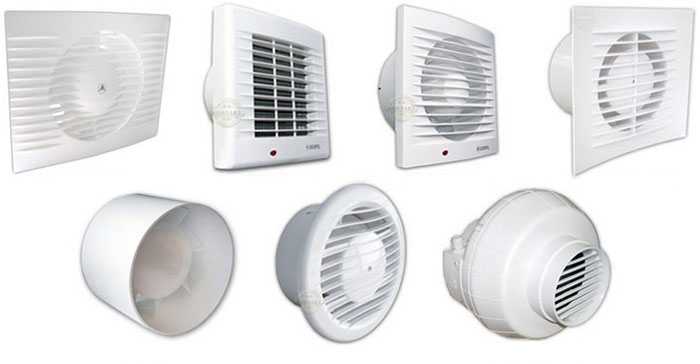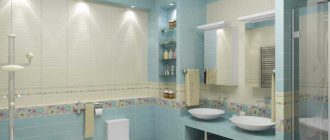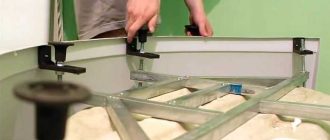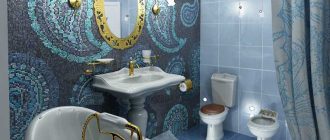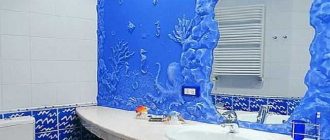A bathroom extractor fan can quickly remove moist air after a bath or shower. This is a small device that is installed at the inlet of the ventilation duct or directly in the route.
Artiklens indhold
Types of fans for the bathroom
According to the device, exhaust fans are:
Most often, the exhaust fan in the bathroom is put axial type. They are inexpensive, cope well with the task if the outputs of the ventilation channels are close to each other. If the distance from the point of entry to the ventilation channel is more than 2 meters, it makes sense to put radial.
According to the method of installation fans are:
With wall and ceiling questions do not arise, everything is clear by the name, but about the channel ones it is worth explaining. This modification is installed in the gap of the ventilation duct. They are used mainly code exhaust channel one, and connect to it should be several rooms, but it is possible to use and on an individual channel.
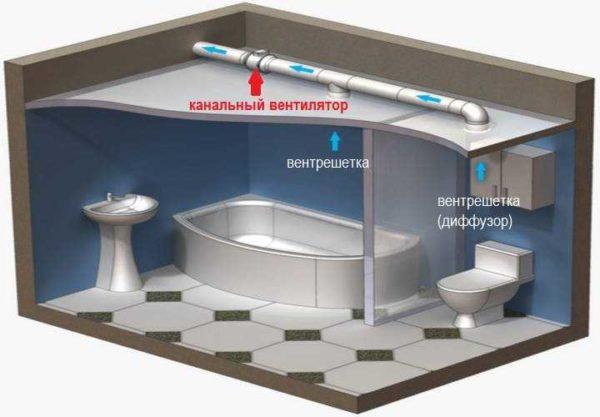
These models are used less often, because of more complicated installation and maintenance (it is harder to get access for preventive cleaning or replacement), but in many cases it is the only option. In private homes, the duct fan in the hood can be taken to the attic, there it is easier to maintain it.
Selection by technical parameters
As any technical device, the exhaust fan in the bathroom should be chosen first of all by technical parameters. It is worth saying at once that the cases are usually made of plastic, and the case itself – waterproof (minimum protection class – IP 24). The shape and type of grille – arbitrary, the color of the case is most often white, but there are also colored.
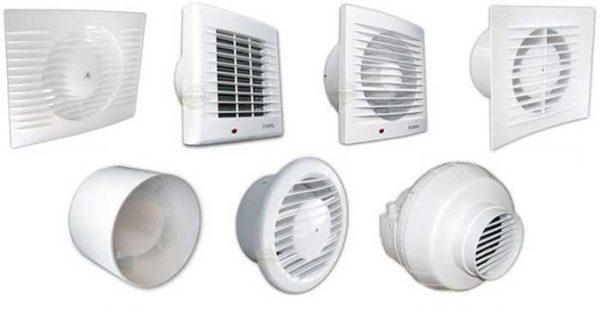
In addition to external features, we choose the diameter of the outlet pipe of the exhaust fan. It is selected depending on the cross-section of the duct (it is better not to narrow, as air exchange will fall).
Air exchange
Choose an exhaust fan in the bathroom should be based on the volume of the ventilated room and the air exchange rate (prescribed by sanitary norms). For bathrooms, the recommended multiplicity is equal to 6 to 8 volumes of air per hour. For families consider 8-fold exchange, for 1-2 people is enough 6-7-fold.
For example, a bathroom has dimensions of 2,2*2,5*2,7 meters. Multiply all the figures to find out the volume, we get 14.85 m3. Rounding, we get that the volume of the bathroom is 15 cubes. We will calculate the eightfold exchange: 15 m2 * 8 = 120 cubic meters per hour. That is, when selecting the performance of the fan, its performance should not be less than 120 cubic meters per hour.

Noise level
The second point to which you should pay attention when choosing a bathroom exhaust fan is the level of noise produced. If the fan will work only during the day, the noise produced should be in the neighborhood of 30-35 dB. This is not very loud, against the background of other noises does not interfere. If the fan in the hood will also work at night, the noise level should be less than 30 dB, or better 20-25 dB.
The quietest fan for the bathroom should be sought among radial models. Axial due to the transmission of vibration from the motor emit louder sounds, but there are models in which these vibrations are minimized by the use of special vibration dampening pads. Another method is the use of rolling bearings. Such axial fans for the bathroom and produce just 22-23 dB, which is very low.
| Name | Mounting type | Operating mechanism | Air exchange (capacity) | Power consumption | Noise level | Additional functions | Rotation speed | Price |
|---|---|---|---|---|---|---|---|---|
| Vents 100 MAT | overhead | axial | 98 cu. m/h | 18 W | 34 dB | timer, delayed switch-off | 2300 rpm | 30-35$ |
| Electrolux EAF-100TH | overhead | axial | 100 cubic meters/hour | 15 W | 33 dB | humidity sensor | without adjustment | 30-35$ |
| VENTS iFan | surface-mounted | axial | 106 cfm/hour | 4.56 W | 31 dB | remote control, humidity sensor | step regulation | 75- 85 $ |
| Soler & Palau SILENT-100 CZ | surface-mounted | axial | 95 cfm/h | 8 W | 27 dB | mechanical control | without adjustment | 25-39$ |
| Blauberg Sileo 125 T | overhead | axial | 187 cfm/h | 17 W | 32 dB | timer, non-return valve | without adjustment | 45-50 $ |
| Systemair CBF 100 | surface-mounted | radial | 110 cfm/h | 45 W | 45 dB | mechanical control | without adjustment | 65-75 $ |
| Systemair BF 100 | overhead | axial | 85 cfm/h | 20 W | 41 dB | mechanical control | 2400 rpm | 32-35 $ |
| Systemair IF 100 | ducted | axial | 87.1 cu. m/h | 14 W | 44 dB | 2432 rpm | 28-35 $ | |
| MARLEY MP-100S (SV-100) | overhead | 10 to 83 m³/h | 1.1 W to 4.1 W | 10 dB to 38 dB | electronic control | infinitely variable control | 209-225 $ | |
| VENTS Quiet 100… (Vents Quiet 100) |
overhead | silent | 97 cubic meters/hour | 7.5 W | 25 dB | check valve, roller bearing | 2300 rpm | 28-35 $ |
| Vents 125 Quiet B (125 Quiet B) | surface-mounted | silent | 185 cu. m/h | 17 W | 32 dB | check valve, roller bearing | 2400 rpm | 42-50$ |
| Domovent VKO 125… | ducted | axial | 185 cubic meters/hour | 16 W | 37 dB | overheating and moisture protection | without adjustment | 7-10$ |
Also pay attention to such a point as the material of the ducting. The fan itself can make little noise, but the metal duct can make noise when the air moves through it. Therefore, it is desirable to use plastic when installing a ventilation system. If there is already a metal box, you can reduce the noise level by gluing it with soundproofing materials. The second way out is to sew it into a box, and fill the gaps with porous soundproofing material. The best way to do this is to use standard soundproofing made of mineral fibers. Mounting foam, of course, is convenient to use, but its soundproofing characteristics are very low. Foam and polystyrene foam are not very good in this regard.
Power consumption
Another parameter is the power consumption. The less this parameter, the less you have to pay for electricity. From this point of view, axial fans for bathroom exhaust are more economical. For a set of high efficiency at low electricity costs, they produce a significant air exchange. Radial in this respect is less favorable: with equal performance they spend 3-4 times more electricity, but the air is transferred to a greater distance.
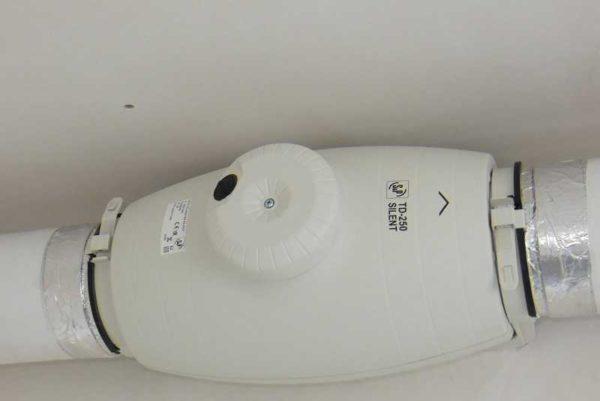
It is also worth remembering that the fan performance (the amount of air moved per unit time) depends on the power consumption. This parameter is also affected by the shape of the impeller and other design features (for example, the presence of rolling bearings), but the greater the volume of air to be pumped, the more powerful the bathroom exhaust fan is required.
Additional functions
In the simplest version, the fan in the bathroom hood is turned on by a separate switch. Some models have a chain, pulling which you can turn it on or off. In this case, the device works for as long as the power supply is on. There are other options:
The most common models of bathroom exhaust fans – with a delayed shutdown after the light is turned off. But they can also be switched on through a separate switch, excluding the light bulb from the circuit. Installations with humidity detector are more economical, because not every visit to the bathroom and turning on the light requires increased ventilation. For example, if you come in to wash your hands, it is hardly worth turning on forced ventilation.
Another convenient option – different speeds of rotation of the blades. In this case, the exhaust fan in the bathroom can change the mode of operation depending on the initial humidity in the room. Switching is manual (mechanical), there is automatic (MARLEY MP-100S).
Check valve on the fan in the bathroom – necessary or not
There are also exhaust fans with a built-in check valve. Sometimes this option is useful – if there is a reverse draft, it will not let the air from the vent system get into the room. But such models are still not very popular. The thing is natural ventilation. Most apartments and houses have natural ventilation. By installing a fan in the ventilation duct, we significantly worsen the exhaust air outlet in a natural way – due to the difference in pressure and draught. Installing a fan with a check valve makes the situation even worse. In this case, forced inducement (with a fan) must work around the clock.
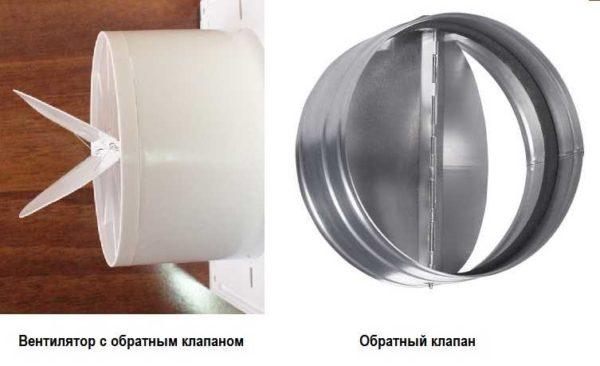
If you decide to put a check valve, it does not necessarily have to go in one case. It can always be installed separately – in the channel in front of the fan.

